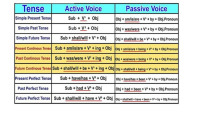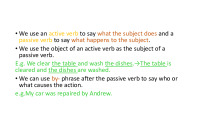The Passive Tense Presentation



The passive. The 20th of November,2020 Friday. We use an. Passives with modals, infinitives and gerunds. Modal passives. Passive infinitives and gerunds. We use to. Passive verbs. Verbs with and without objects. Verbs with two objects. We can create. When a verb with two objects is used only in one active structure. The uses of the passive. Impersonal style. Focusing on what is done and who is affected. We use passives when we describe a process by talking about what is done. Reporting in the passive. We can use reporting verbs in the passive when we don‘t know. Passives with by- phrases. The agent is the person or thing that does or causes the action. Ergatives. Ergatives are transitive verbs that are used without an object. Passives with get. We can use get+V3 instead of be+ V3 as a passive. Passive with have. Have+ object + V3 When the subject causes the action.
We create passives from verbs wich can have objects (transitive verbs), not from verbs wich don‘t have objects (intransitive verbs). e.g.He repaired the bike. The bike was repaired. Nothing happened. We usually create passives from verbs which describe actions, not states. e.g. They scored a goal in the last five minutes. A goal was scored i the last five minutes. My sister has two sons. We create passives from transitive phrasal verbs , not from intransitive phrasal verbs. e.g. She looked her house up. They broke into it. Her house was locked up. It was broken into. My cold went away.
Focusing on what is done and who is affected.
Have+ object + V3 When the subject causes the action, often by arranging for someone else to do it. When the subject experiences the action or event, especially if it is something unexpected or upleasant.
- Languages Presentations
- MS PowerPoint 123 KB
- 2021 m.
- English
- 15 pages (1662 words)
- Gymnasium
- Aušra

















